

USGS scientist takes aim at Great Lakes invaders
Rising Higher: A Research Lab Built from the Ground Up - Part 2
Great Lakes Researchers Go Down Under
Rising Higher: A Research Lab Built from the Ground Up - Part 1
A Monograph on Ciscoes of the Laurentian Great Lakes and Lake Nipigon
WATCH: Acoustic Telemetry Provides In-Depth Look into Fish Behavior
Eel-Ladder Style Traps: A New Lamprey Control Tool
A Lampricide Treatment: Up-Close
Lamprey Nativeness Claims Annulled by Commission's Eshenroder
A Population at the Edge: American Eel Declining at the Extremes
Celebrating 60 Years of Successful Sea Lamprey Control, Science, and Cross-Border Collaboration!
Great Lakes Scientists Use Acoustic Telemetry to Reveal the Secret Lives of Fish
Hammond Bay Biological Station: The Nexus for Research and Restoration on the Great Lakes
Big Consequences of Small Invaders
New Sea Lamprey Estimates Suggest a Dramatically Decreased Population
Conducting Research through Cooperative Partnerships: The PERM Agreement
Living on the Edge: A Closer Look at Coastal Communities
Asian Carp: The War Isn't Over
Managing the Lake Huron Fishery
Understanding Sea Lamprey: Mapping the Genome and Identifying Pheromones
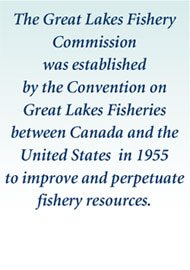
- Understanding Sea Lamprey: Mapping the Genome and Identifying Pheromones
- American Eels in Peril
- Managing the Lake Huron Fishery
Understanding Sea Lamprey: Mapping the Genome and Identifying Pheromones
By Mike Siefkes and Jill Wingfield, Great Lakes Fishery Commission
Can the lamprey's unique genomic sequence and its distinctive body odors be used against it in the development of novel control techniques? Two complementary lines of research are progressing rapidly and could transform the sea lamprey control program in the Great Lakes. One track is looking deep into the sea lamprey genome - the most basic building block of this animal - to find weaknesses. The other track is investigating how sea lampreys use pheromones to communicate, particularly during spawning. Together, scientists on these projects are working side-by-side to understand what makes a sea lamprey tick and to use that information to exploit vulnerabilities in their life cycle.
The Genome Project
A commission-funded project, led by Dr. Weiming Li from Michigan State University, explores the sea lamprey genome, which contains DNA sequences that code for genes that are organized on chromosomes. Genes are the instructions to the animal about all its physiological processes including migration, mating, and responses to danger. The project took advantage of an approximately $18 million grant awarded to Washington University by the National Institutes of Health (NIH) to sequence the sea lamprey genome. With a better understanding of the genome, Dr. Li and his team will analyze the genetic code and identify potential opportunities to develop novel control strategies.
Specifically, the genome project proposed three primary objectives: 1) develop a database of coding sequences available to researchers; 2) examine the sea lamprey genome to identify genes with implications for new control strategies; and 3) characterize selected gene functions throughout the lamprey life-cycle for potential use in control efforts.
The commission was pleased to learn that through the collaborative efforts of many universities and scientists, these objectives were not only met but also vastly exceeded. For example:
- The planned open-access database was originally intended to focus only on select coding-sequences within the genome, yet the database now provides access to more than 2.3 billion sequences.
- The original objective was to examine approximately 1,000 genes from four gene families; however, more than 24,000 genes from more than 100 gene families were examined in total.
- Because of the complexities associated with decoding the sea lamprey genome, the third objective proposed to examine only two gene families for potential control strategies. Yet, after overcoming some major challenges, researchers were able to map the entire sea lamprey genome for most body tissues across the various life stages of the sea lamprey.
Pheromones and Alarm Cues
Genome work has advanced understanding of pheromone communication, one of the commission's promising new areas for control, by allowing for the rapid identification of specific pheromone receptors. Further understanding of the sea lamprey's pheromone communication system will allow for better development of pheromone control strategies. Below is a brief description of each pheromone:
MATING PHEROMONE. Research conducted by Dr. Li has shown that during the spawning season, male sea lampreys release mating pheromones that lure female sea lampreys to their nest. Two compounds, 3-keto-petromyzonol sulfate (3kPZS) a cue that influences behavior and 3-keto-allocholic acid (3kACA) a cue that likely promotes sexual maturation, have been identified and synthesized in the lab. Field trials conducted over the past decade indicate that 3kPZS effectively acts as an attractant in habitats typically used by spawning sea lampreys. Management-scale field trials are now underway to determine if 3kPZS (as trap bait) can increase the number of sea lampreys captured. Other research is also underway to determine other effective uses of the mating pheromones for sea lamprey control.
MIGRATORY PHEROMONE. Drs. Peter Sorensen and Thomas Hoye at the University of Minnesota have characterized three compounds - PADS, PSDS, and PZS - that are components of the migratory pheromone. This pheromone is released by stream-resident larvae to attract migrating adults to spawning streams. After synthesizing these compounds, field trials are underway to determine if they can be used to influence stream selection by migrating adults. The ability to guide sea lampreys to streams where spawning and larval habitat are poor, that can be treated effectively with lampricides, or where high numbers can be captured in traps would be a huge breakthrough for the sea lamprey control program.
ALARM CUES. The avoidance of harm is also mediated by olfaction in the sea lamprey. Recent research conducted by Dr. Michael Wager at Michigan State University confirms that sea lampreys actively avoid the odor from decaying sea lamprey carcasses; this response indicates that sea lampreys may be successfully avoiding areas where their reproductive success is threatened. For example, the presence of these alarm cues may warn other sea lampreys to predatory dangers or unsuitable habitats resulting in a high incidence of mortality. Once characterized, alarm cues may add to sea lamprey control by blocking sea lampreys from migrating into streams.
An increased understanding of sea lamprey reproductive behavior and communication cues has significant implications for the sea lamprey control program. Using pheromones to influence the behavior of sea lampreys (e.g. swimming towards a particular stream or even into a trap) may increase the effectiveness of sea lamprey control and may even significantly reduce the commission's reliance on chemical control - one of the management milestones identified in the Strategic Vision for the Great Lakes Fishery Commission for the First Decade of the New Millennium. The commission is confident that pheromone-mediated behavioral manipulation is the most promising next step for one of the most successful invasive species control programs in the world.
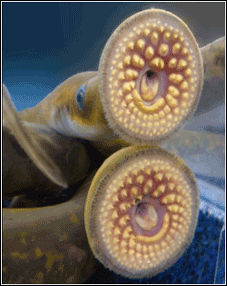
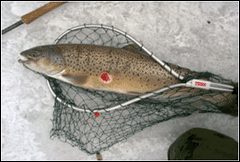
Sea lampreys attach to fish with a suction cup mouth, rasp a hole through the fish's scales and skin, and feed on the fish's body fluids. PHOTOS: T. LAWRENCE, GLFC (TOP); V. DZSURDZSA (BOTTOM)
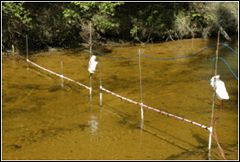
Sea lampreys that are part of the field trials are marked with an electronic tag; as lamprey pass by receivers in the stream, the tag is read and key data (e.g. location, time) is recorded. PHOTO: T. LAWRENCE, GLFC
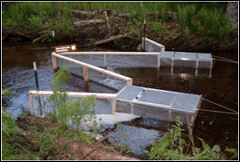
During pheromone field trials, one trap is baited with the synthesized pheromone. Researchers observe lamprey behavior downstream - and near the opening of - each trap and record the number of animals in each trap to determine if the baited trap is more effective at capturing lampreys. PHOTO: T. LAWRENCE, GLFC



